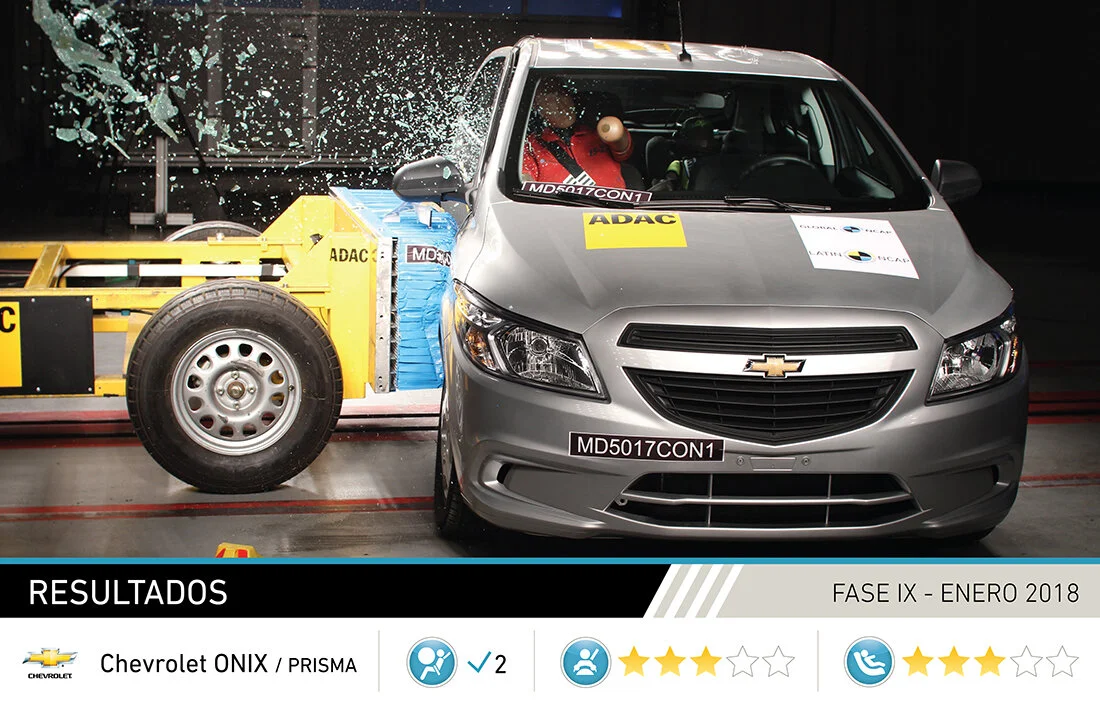Five Stars For Volkswagen’s Virtus While GM’s Onix Improves To Three Stars
Latin NCAP’s first round of results for 2018 was released today with encouraging results to begin the year for the Virtus and the improved Onix. In our latest testing, the Virtus followed the Polo five stars while the Onix just achieved three stars after improvements implemented following the 2017 zero star result.
The recently launched Volkswagen Virtus, produced in Brazil, achieved five stars for Adult Occupant Protection and five stars for Child Occupant Protection. As the Virtus and the Polo are the same car from the front up to the B-pillar, the frontal impact and pole impact of the Polo tests and their results are valid for the Virtus in Adult Occupant Protection. Child Occupant frontal crash Protection is considered the same as the Polo as both cars also share the same platform and rear seats. But as the Virtus has a longer wheel base than the Polo the side impact test had to be performed on the Virtus, where it showed the same performance as the Polo side impact. The standard fitted side thorax-head airbags showed robust performance in both side impact scenarios. The Electronic Stability Control (ESC) meets the Latin NCAP fitment rate conditions, and matched the required performance criteria in the test. For child safety, the Virtus is i-size approved and offers ISOFIX anchorages, airbag disconnection switch and 3 point belts for all passengers as standard allowing it to achieve top stars in Child Occupant Protection. The Virtus as well as the Polo offers Pedestrian Protection as standard, which allowed the model to also receive the Latin NCAP Advanced Award for such an important safety feature.
The recently improved Chevrolet Onix just managed to achieve three stars for adult occupant protection and three stars for child occupant protection. The Chevrolet Onix, which is manufactured in Brazil, had been tested in 2017 where it disappointed with zero star rating for adult occupant protection. Chevrolet decided to improve the Onix and to sponsor a new assessment of the model in 2018. The Onix produced as from January 15th 2018 (as from VIN 9BGKS48U0JG313644) was improved with structural reinforcements for the side impact protection, energy absorption elements for the side impact adult protection in the doors, ISOFIX anchorages and a new seatbelt for the driver. The adult occupant protection just managed to achieve three stars showing just weak protection for the chest of the adult in frontal crash and also side impact. The Child Occupant protection showed a three star result with marginal protection for the frontal test for the three years old dummy. The Onix still offers a lap belt in the rear centre seat. Latin NCAP encourages Chevrolet to improve robustness of the protection offered by this model to assure better protection performances in the future.
Alejandro Furas, Secretary General of Latin NCAP said:
“Virtus is further proof that the local industry can produce five star cars at more and more affordable prices offering better safety and earlier than any governmental requirement in our region. The Onix improvements are great news for our market. It is encouraging to see these improvements from such relevant automakers. Once again Latin NCAP demonstrated that testing models and publishing their results are the most powerful and efficient tools to improve Latin America’s market vehicle safety even earlier and at a higher level than any regional government. That is why Latin NCAP is calling for all governments in Latin America to urgently adopt both the UN’s front and side impact crash test standards certification, ESC and Pedestrian protection and in the meantime make Latin NCAP tests mandatory for all cars in the market. By doing this, all consumers will have clear information on the safety offered by the car that they plan to buy.”
Ricardo Morales Rubio, Latin NCAP Chairman of the Board of Directors said:
“To start the year with these results is very encouraging. The manufacturers want to show that they are able to produce vehicles with good levels of safety and also that they can improve a poor rating obtained in Latin NCAP. Once again it is demonstrated that Latin NCAP good results and not so good results are helpful as they encourage the market to improve vehicles’ safety. From our position, we congratulate Volkswagen and Chevrolet and we hope that the other manufacturers continue on this same path”.
The next round of Latin NCAP results will be released in March.
Volkswagen Virtus
Read the full crash test report / Download the crash test video
Download the ESC test video / Download crash test image
Chevrolet Onix
Read the full crash test report / Download the crash test video
Download crash test image
About Latin NCAP
The New Car Assessment Programme for Latin America and the Caribbean, Latin NCAP, was launched in 2010 to develop a regional system of independent crashworthiness and safety rating across Latin America and Caribbean (LAC). Latin NCAP replicates similar consumer testing programmes developed over the last thirty years in North America, Europe, Asia and Australia, and which have proved to be very effective in improving the safety of motor vehicles. Since 2010 Latin NCAP has published the results of more than ninety cars in nine test phases.
Latin NCAP acknowledges the support received by the Global New Car Assessment Programme (Global NCAP), International Consumer Research and Testing (ICRT), FIA Foundation, the Inter-American Development Bank (IDB) and Bloomberg Philanthropies Global Road Safety Initiative.
Latin NCAP is an Associate member of Global NCAP and supports the United Nations Decade of Action for Road Safety 2011-2020 and the Stop the Crash Partnership.
More info: www.latinncap.com






